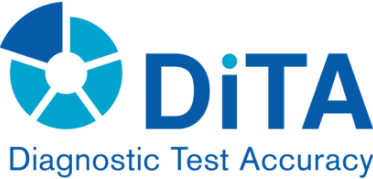This page contains the indexing criteria and codes used in DiTA:
1. Criteria
Criteria for inclusion of primary studies
The following criteria are used to identify primary diagnostic test accuracy studies that are eligible for inclusion on DiTA. To be included in the database:
- The study must investigate both a pathology and patients that a physiotherapist could assess in clinical practice. Studies performed on animals other than humans will not be included on DiTA. If the reference standard of the study is applied to a person after death, it can still be included on DiTA as long as the index test is performed prior to death. For the study to be included, the pathology must be specific and be able to be identified categorically. Studies that attempt to measure the severity of pathology rather than the presence or absence of pathology will not be included. Studies that predict the future development of pathology (such as prediction of knee osteoarthritis) will not be included.
- The study must investigate an index test that physiotherapists could perform themselves, rather than one that they would order (such as a radiograph). If the index test is a group of tests then a physiotherapist must be able to perform all of the tests separately for the study to be included. If an index test is not a standardised test, it needs to be described so that a clinician can reproduce the test and know what is considered a positive and negative result. It is not necessary that, in the study, the test is conducted by a physiotherapist.
- The study must investigate the concordance of an index test with a reference standard. To be eligible for inclusion, the authors must have attempted to include at least four subjects in the study. The intention must have been to sample from a population expected to contain people who did and did not have the pathology. Studies that intentionally sampled only patients known to have the pathology (sensitivity studies) and studies that intentionally sampled only patients known not to have the pathology (specificity studies) are not included.
- The study must be a full primary research paper (not an abstract) that is published in a peer-reviewed journal.
Studies published in any language are included. Judgments as to the quality of the methods used or whether the authors actually did what they claimed are not to be used to decide if a study is eligible for inclusion in DiTA.
Criteria for inclusion of systematic reviews
Systematic reviews evaluating diagnostic tests related to physiotherapy are also indexed on DiTA. Systematic reviews (sometimes called meta-analyses, although the term is used inconsistently) are distinguished from traditional (“narrative”) reviews by the use of methods to minimise bias. The following criteria are used to distinguish between systematic reviews that are eligible for inclusion on DiTA and those that are not:
- The review must contain a Methods section that describes the search strategy and inclusion criteria.
- The review must include at least one study or review (or explicitly search for but not find a study or review) that satisfies the criteria for inclusion on DiTA.
- The review must be a full paper (not an abstract) in a peer-reviewed journal.
Reviews published in any language are included. Judgments as to the quality of the methods used or whether the authors actually did what they claimed are not to be used to decide if a systematic review is eligible for inclusion on DiTA.
2. Codes
Subdiscipline
These categories refer to various aspects of physiotherapy. If the area for a particular paper does not fit under any of these, the code “no appropriate value in this field” should be used.
cardiothoracics
includes, but is not restricted to, papers evaluating acute and rehabilitation cardiothoracic interventions or fitness training on those with conditions affecting the cardiothoracic system. This subdiscipline does not include studies of general fitness training among patient populations. Studies of general fitness training for healthy populations are not indexed on PEDro
continence and women’s health
includes, but is not restricted to male and female incontinence and pre- and post-natal interventions for the mother
ergonomics and occupational health
includes, but is not restricted to, interventions based at workplaces or on workers for work-related conditions
gerontology
includes papers where the average age of the study sample is over 60, and papers on conditions which commonly affect older people (eg, arthritis)
musculoskeletal
includes, but is not restricted to, low back pain, rheumatoid disease, entrapment syndromes, neuralgia
neurology
includes, but is not restricted to, lesions of the central and peripheral nervous systems excluding those whose primary presentation is pain or paraesthesia such as carpal tunnel syndrome, neuralgia or sciatica
oncology
includes papers evaluating interventions for health problems due to tumours or cancers
orthopaedics
includes only fractures and intervention before or after orthopaedic surgery (eg, knee replacements, ligament repairs)
paediatrics
includes papers where the average age of the study sample is under 16, and papers on conditions which commonly affect children (eg, cystic fibrosis)
sports
includes papers which specifically mention sports injuries as well as conditions which commonly affect sports people (eg, ligament repairs)
no appropriate value in this field
Body part
These categories refer to the body part being examined. If there is no one body part being examined, or if the diagnostic test is targeted at whole body systems rather than a body part, the code “no appropriate value in this field” should be used.
head or neck
upper arm, shoulder or shoulder girdle
forearm or elbow
hand or wrist
chest (for cardiothoracic studies)
thoracic spine
lumbar spine, SIJ or pelvis
perineum or genito-urinary system
thigh or hip
lower leg or knee
foot or ankle
no appropriate value in this field
Pathology
These categories refer to various pathologies. If the pathology for a particular paper does not fit under any of these, the code “no appropriate value in this field” should be used.
articular
cardiovascular
genito-urinary
muscular
neurological
respiratory
skeletal
no appropriate value in this field
Index test
These categories refer to index tests. If the tests for a particular paper do not fit under any of these, the code “no appropriate value in this field” should be used.
health technology
physical examination
questionnaire
mixed
no appropriate value in this field
Reference test
These categories refer to reference tests. If the tests for a particular paper do not fit under any of these, the code “no appropriate value in this field” should be used.
clinician opinion
health technology
injection
patient opinion
physical examination
questionnaire
review of medical records
surgery
mixed
no appropriate value in this field



